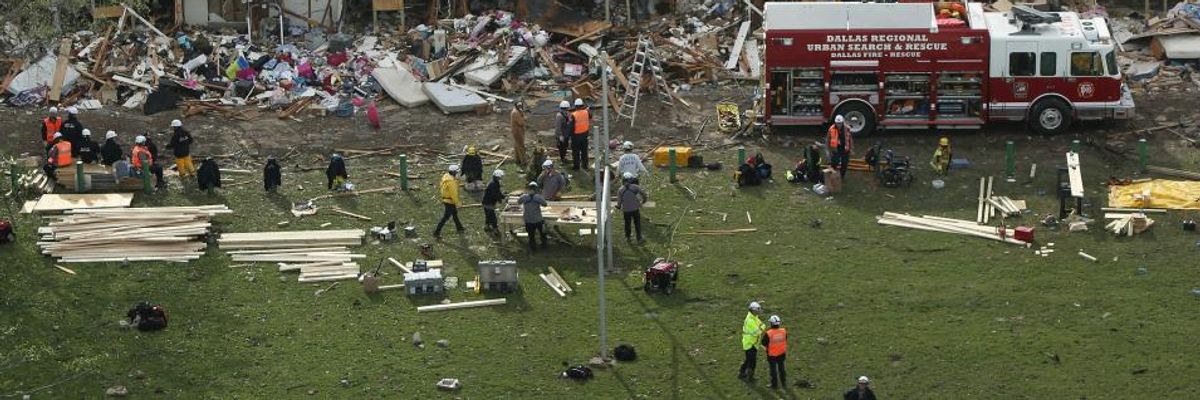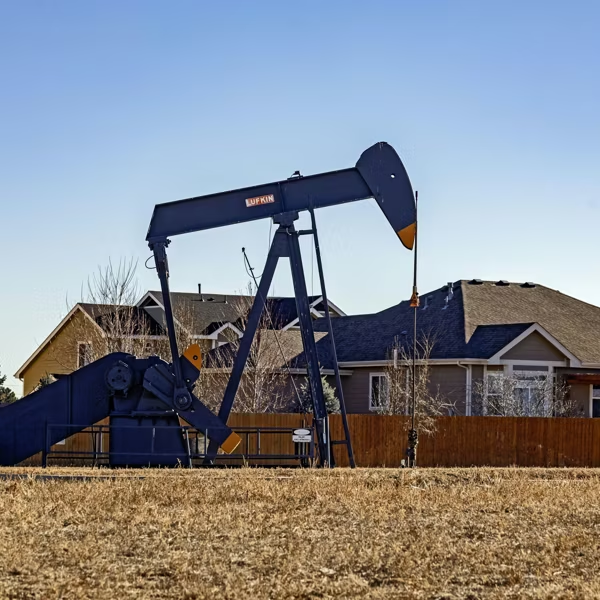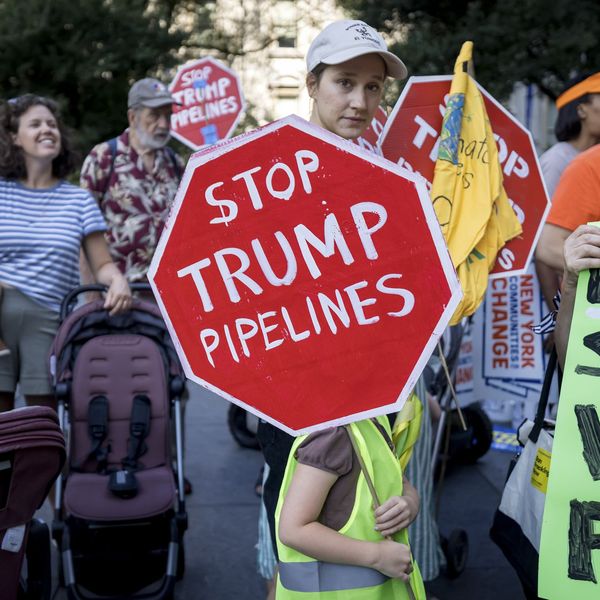
Search and rescue workers combed through what remained of a 50-unit apartment building the day after an explosion at the West Fertilizer Company destroyed the building April 18, 2013 in West, Texas. (Photo: Chip Somodevilla/Getty Images)
Environmental Justice Advocates Blast Trump EPA for 'Dangerous' Rollback of Chemical Disaster Rule
"Safety requirements at these facilities should be stepped up, not rolled back. But this is what we've come to expect from the Trump EPA."
Environmental justice groups condemned the Trump administration Thursday for catering to the chemical industry after the Environmental Protection Agency finalized a rollback of Obama-era disaster prevention measures that were implemented to protect workers at and residents of communities with chemical plants.
"Today's action by the EPA has only increased the chances that people who live in these fence line neighborhoods, which are disproportionately lower-income communities of color, could be seriously harmed or killed."
--Ken Cook, EWG
The Trump EPA's changes to Chemical Disaster Rule (pdf) crafted under former President Barack Obama came after years of delays and industry opposition to stricter regulations.
"Those who work in or live near a chemical or petroleum plant are already at far greater risk than the average American," Environmental Working Group (EWG) president Ken Cook said in a statement. "Today's action by the EPA has only increased the chances that people who live in these fence line neighborhoods, which are disproportionately lower-income communities of color, could be seriously harmed or killed."
"Safety requirements at these facilities should be stepped up, not rolled back," Cook added. "But this is what we've come to expect from the Trump EPA."
Dr. Andrew Rosenberg, director of the Center for Science and Democracy at the Union of Concerned Scientists (UCS), echoed Cook's criticism.
"Fence line communities continue to suffer the extraordinary risks brought on by big industrial facilities and all too frequent chemical accidents," said Rosenberg. "This rule adds insult to injury by refusing to address the need to reduce disaster risks and consider community needs. That is completely unacceptable."
A few months after a 2013 explosion at a fertilizer plant in West, Texas killed 15 people, injured over 160, and leveled hundreds of homes, Obama signed an executive order calling for chemical safety improvements nationwide. The Chemical Disaster Rule to strengthen federal Risk Management Program (RMP) regulations was published just before President Donald Trump took office and set to take effect in 2017.
However, Trump's first EPA administrator, Scott Pruitt, delayed its implementation, which prompted an ongoing legal battle. In May 2018, the Trump administration proposed changes to the RMP that aligned with the chemical industry's wishes.
The EPA claimed Thursday that the Trump administration's final rule "modifies and improves the existing rule to remove burdensome, costly, unnecessary amendments while maintaining appropriate protections and ensuring first responders have access to all of the necessary safety information."
Former coal lobbyist and current EPA administrator Andrew Wheeler said, "Today's final action addresses emergency responders' longstanding concerns and maintains important public safety measures while saving Americans roughly $88 million per year."
The EPA also circulated praise for the final rule from from a few first responders, the trade organization Agricultural Retailers Association, and Republican state attorneys general and secretaries as well as members of Congress. E&E News reported that the American Chemistry Council, another trade group, also welcomed the new rule.
Critics, however, highlighted concerns that the RPM changes will endanger workers and community members.
"Once again, workers, communities of color, and low-income communities have been placed squarely in harm's way by the Trump administration," declared Michele Roberts, national co-coordinator of the Environmental Justice Health Alliance for Chemical Policy Reform. "EPA's own analysis demonstrated that our communities are at disproportionate risk of chemical disasters, on top of the many other toxic hazards we experience daily. Ignoring that evidence is further proof that this administration has no regard for the health and safety of workers and communities. This is environmental racism."
EWG explained that the Trump rule rescinds:
- The requirement that chemical companies must determine the root causes of spills or explosions.
- The requirement that an independent third party investigate spills, explosions and other disasters.
- Training requirements for supervisors of plant operations.
- The requirement for the plant owner or operators to keep safety information up to date.
- The requirement that plant owners release chemical hazard information to the public upon request.
"This administration is gutting the few protections we have against chemical explosions and other toxic disasters, just to appease chemical companies who only worry about their own profit," 13 groups said in a joint statement. "Yet for the millions of families and children who live by chemical facilities, this is not about money, it's about surviving chemical disasters. Lives depend on this rule."
The 13 groups, which won a legal battle in August 2018 vacating the Trump EPA's delay of the rule, were represented by the nonprofit law firm Earthjustice. In response to the EPA's announcement Thursday, Earthjustice attorney Emma Cheuse said that "there is no excuse for exposing families and children to preventable chemical disasters."
"We will continue working with people in the most affected communities," Cheuse vowed, "to defend public safety and to oppose Trump's dangerous rollback of the Chemical Disaster Rule."
An Urgent Message From Our Co-Founder
Dear Common Dreams reader, The U.S. is on a fast track to authoritarianism like nothing I've ever seen. Meanwhile, corporate news outlets are utterly capitulating to Trump, twisting their coverage to avoid drawing his ire while lining up to stuff cash in his pockets. That's why I believe that Common Dreams is doing the best and most consequential reporting that we've ever done. Our small but mighty team is a progressive reporting powerhouse, covering the news every day that the corporate media never will. Our mission has always been simple: To inform. To inspire. And to ignite change for the common good. Now here's the key piece that I want all our readers to understand: None of this would be possible without your financial support. That's not just some fundraising cliche. It's the absolute and literal truth. We don't accept corporate advertising and never will. We don't have a paywall because we don't think people should be blocked from critical news based on their ability to pay. Everything we do is funded by the donations of readers like you. Will you donate now to help power the nonprofit, independent reporting of Common Dreams? Thank you for being a vital member of our community. Together, we can keep independent journalism alive when it’s needed most. - Craig Brown, Co-founder |
Environmental justice groups condemned the Trump administration Thursday for catering to the chemical industry after the Environmental Protection Agency finalized a rollback of Obama-era disaster prevention measures that were implemented to protect workers at and residents of communities with chemical plants.
"Today's action by the EPA has only increased the chances that people who live in these fence line neighborhoods, which are disproportionately lower-income communities of color, could be seriously harmed or killed."
--Ken Cook, EWG
The Trump EPA's changes to Chemical Disaster Rule (pdf) crafted under former President Barack Obama came after years of delays and industry opposition to stricter regulations.
"Those who work in or live near a chemical or petroleum plant are already at far greater risk than the average American," Environmental Working Group (EWG) president Ken Cook said in a statement. "Today's action by the EPA has only increased the chances that people who live in these fence line neighborhoods, which are disproportionately lower-income communities of color, could be seriously harmed or killed."
"Safety requirements at these facilities should be stepped up, not rolled back," Cook added. "But this is what we've come to expect from the Trump EPA."
Dr. Andrew Rosenberg, director of the Center for Science and Democracy at the Union of Concerned Scientists (UCS), echoed Cook's criticism.
"Fence line communities continue to suffer the extraordinary risks brought on by big industrial facilities and all too frequent chemical accidents," said Rosenberg. "This rule adds insult to injury by refusing to address the need to reduce disaster risks and consider community needs. That is completely unacceptable."
A few months after a 2013 explosion at a fertilizer plant in West, Texas killed 15 people, injured over 160, and leveled hundreds of homes, Obama signed an executive order calling for chemical safety improvements nationwide. The Chemical Disaster Rule to strengthen federal Risk Management Program (RMP) regulations was published just before President Donald Trump took office and set to take effect in 2017.
However, Trump's first EPA administrator, Scott Pruitt, delayed its implementation, which prompted an ongoing legal battle. In May 2018, the Trump administration proposed changes to the RMP that aligned with the chemical industry's wishes.
The EPA claimed Thursday that the Trump administration's final rule "modifies and improves the existing rule to remove burdensome, costly, unnecessary amendments while maintaining appropriate protections and ensuring first responders have access to all of the necessary safety information."
Former coal lobbyist and current EPA administrator Andrew Wheeler said, "Today's final action addresses emergency responders' longstanding concerns and maintains important public safety measures while saving Americans roughly $88 million per year."
The EPA also circulated praise for the final rule from from a few first responders, the trade organization Agricultural Retailers Association, and Republican state attorneys general and secretaries as well as members of Congress. E&E News reported that the American Chemistry Council, another trade group, also welcomed the new rule.
Critics, however, highlighted concerns that the RPM changes will endanger workers and community members.
"Once again, workers, communities of color, and low-income communities have been placed squarely in harm's way by the Trump administration," declared Michele Roberts, national co-coordinator of the Environmental Justice Health Alliance for Chemical Policy Reform. "EPA's own analysis demonstrated that our communities are at disproportionate risk of chemical disasters, on top of the many other toxic hazards we experience daily. Ignoring that evidence is further proof that this administration has no regard for the health and safety of workers and communities. This is environmental racism."
EWG explained that the Trump rule rescinds:
- The requirement that chemical companies must determine the root causes of spills or explosions.
- The requirement that an independent third party investigate spills, explosions and other disasters.
- Training requirements for supervisors of plant operations.
- The requirement for the plant owner or operators to keep safety information up to date.
- The requirement that plant owners release chemical hazard information to the public upon request.
"This administration is gutting the few protections we have against chemical explosions and other toxic disasters, just to appease chemical companies who only worry about their own profit," 13 groups said in a joint statement. "Yet for the millions of families and children who live by chemical facilities, this is not about money, it's about surviving chemical disasters. Lives depend on this rule."
The 13 groups, which won a legal battle in August 2018 vacating the Trump EPA's delay of the rule, were represented by the nonprofit law firm Earthjustice. In response to the EPA's announcement Thursday, Earthjustice attorney Emma Cheuse said that "there is no excuse for exposing families and children to preventable chemical disasters."
"We will continue working with people in the most affected communities," Cheuse vowed, "to defend public safety and to oppose Trump's dangerous rollback of the Chemical Disaster Rule."
Environmental justice groups condemned the Trump administration Thursday for catering to the chemical industry after the Environmental Protection Agency finalized a rollback of Obama-era disaster prevention measures that were implemented to protect workers at and residents of communities with chemical plants.
"Today's action by the EPA has only increased the chances that people who live in these fence line neighborhoods, which are disproportionately lower-income communities of color, could be seriously harmed or killed."
--Ken Cook, EWG
The Trump EPA's changes to Chemical Disaster Rule (pdf) crafted under former President Barack Obama came after years of delays and industry opposition to stricter regulations.
"Those who work in or live near a chemical or petroleum plant are already at far greater risk than the average American," Environmental Working Group (EWG) president Ken Cook said in a statement. "Today's action by the EPA has only increased the chances that people who live in these fence line neighborhoods, which are disproportionately lower-income communities of color, could be seriously harmed or killed."
"Safety requirements at these facilities should be stepped up, not rolled back," Cook added. "But this is what we've come to expect from the Trump EPA."
Dr. Andrew Rosenberg, director of the Center for Science and Democracy at the Union of Concerned Scientists (UCS), echoed Cook's criticism.
"Fence line communities continue to suffer the extraordinary risks brought on by big industrial facilities and all too frequent chemical accidents," said Rosenberg. "This rule adds insult to injury by refusing to address the need to reduce disaster risks and consider community needs. That is completely unacceptable."
A few months after a 2013 explosion at a fertilizer plant in West, Texas killed 15 people, injured over 160, and leveled hundreds of homes, Obama signed an executive order calling for chemical safety improvements nationwide. The Chemical Disaster Rule to strengthen federal Risk Management Program (RMP) regulations was published just before President Donald Trump took office and set to take effect in 2017.
However, Trump's first EPA administrator, Scott Pruitt, delayed its implementation, which prompted an ongoing legal battle. In May 2018, the Trump administration proposed changes to the RMP that aligned with the chemical industry's wishes.
The EPA claimed Thursday that the Trump administration's final rule "modifies and improves the existing rule to remove burdensome, costly, unnecessary amendments while maintaining appropriate protections and ensuring first responders have access to all of the necessary safety information."
Former coal lobbyist and current EPA administrator Andrew Wheeler said, "Today's final action addresses emergency responders' longstanding concerns and maintains important public safety measures while saving Americans roughly $88 million per year."
The EPA also circulated praise for the final rule from from a few first responders, the trade organization Agricultural Retailers Association, and Republican state attorneys general and secretaries as well as members of Congress. E&E News reported that the American Chemistry Council, another trade group, also welcomed the new rule.
Critics, however, highlighted concerns that the RPM changes will endanger workers and community members.
"Once again, workers, communities of color, and low-income communities have been placed squarely in harm's way by the Trump administration," declared Michele Roberts, national co-coordinator of the Environmental Justice Health Alliance for Chemical Policy Reform. "EPA's own analysis demonstrated that our communities are at disproportionate risk of chemical disasters, on top of the many other toxic hazards we experience daily. Ignoring that evidence is further proof that this administration has no regard for the health and safety of workers and communities. This is environmental racism."
EWG explained that the Trump rule rescinds:
- The requirement that chemical companies must determine the root causes of spills or explosions.
- The requirement that an independent third party investigate spills, explosions and other disasters.
- Training requirements for supervisors of plant operations.
- The requirement for the plant owner or operators to keep safety information up to date.
- The requirement that plant owners release chemical hazard information to the public upon request.
"This administration is gutting the few protections we have against chemical explosions and other toxic disasters, just to appease chemical companies who only worry about their own profit," 13 groups said in a joint statement. "Yet for the millions of families and children who live by chemical facilities, this is not about money, it's about surviving chemical disasters. Lives depend on this rule."
The 13 groups, which won a legal battle in August 2018 vacating the Trump EPA's delay of the rule, were represented by the nonprofit law firm Earthjustice. In response to the EPA's announcement Thursday, Earthjustice attorney Emma Cheuse said that "there is no excuse for exposing families and children to preventable chemical disasters."
"We will continue working with people in the most affected communities," Cheuse vowed, "to defend public safety and to oppose Trump's dangerous rollback of the Chemical Disaster Rule."

